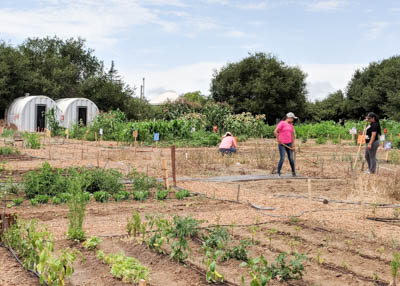Campus News
Research partnership will highlight STEM learning in local community garden
A grant from the Spencer Foundation will help UC Santa Cruz researchers document the many types of STEM learning taking place in a Latinx immigrant-led community garden in Watsonville.

A $50,000 grant from the Spencer Foundation will help UC Santa Cruz education researchers document the many types of STEM learning taking place in a Latinx immigrant-led community garden at Calabasas Elementary School in Watsonville.
These efforts strengthen a longstanding partnership between the university and the community to support the garden as a resource for education, health, and belonging. Many of the families who use the Calabasas Community Garden have at least one parent who is a farmworker. The garden provides a source of healthy food and a space to gather for afterschool activities, but it’s also a place for families to share knowledge and work together to solve problems.
Gardeners collaborate to determine the best positioning and arrangement of crops to maximize use of space and meet the needs of every plant. They also experiment with adapting traditional cultivation strategies and plant varieties from their ancestral homelands to fit the unique growing conditions of Pajaro Valley. Researchers say these are all effective forms of intergenerational learning in science, technology, engineering, and mathematics (STEM).
The Spencer Foundation funding will support a study of this learning that will bring increased recognition to this aspect of what gardeners are accomplishing together.
“People are engaging in scientific inquiry and engineering problem solving in this community garden,” said Linnea Beckett, a principal investigator on the new grant. “There’s a lot of STEM happening in the garden, and everyone from 80-year-old great grandfathers to the littlest kids in a family are participating in it. But the type of learning we see in the garden is different from what you see in a typical traditional classroom.”
Beckett is the director of UCSC’s (H)ACER program—which recruits undergraduate students from College Nine and College Ten as researchers and after-school program interns in the community garden—and over the years, she’s been informally observing the educational models that are at work in the space. One important element is that learning in the garden doesn’t rely on traditional hierarchical roles that designate one person as the teacher or expert and another as the student. Instead, everyone contributes their own unique insights, and learning happens together as a group.
The applied STEM learning happening in the garden also challenges educators to reimagine how STEM is defined and what its practice can look like.

to solve problems in the garden. Photo courtesy of (H)ACER.
“It goes back to this notion of questioning who gets to do STEM,” said Samuel Severance, an assistant professor of education and a co-principal investigator on the grant alongside Beckett. “A lot of communities have historically not been included in the STEM conversation. But when their expertise is valued, folks have a better opportunity to see themselves as practitioners of STEM and to put themselves on trajectories to continue to use STEM to contribute to their communities and to do things that are meaningful in their lives.”
For many of the families who participate in the community garden, one of the most meaningful applications of STEM is supporting the health and well-being of young people in the community. Yolonda Perez, whose daughters both previously attended Calabasas Elementary School, has organized community involvement in the garden for years. She says many families share stories about how the garden has made a positive impact in their children’s lives.
“Children are physically and mentally healthier because the garden is getting them outside and getting them interested in things like plants and flowers and butterflies and insects,” Perez said. “We can teach the kids that there’s another world outside of television and computer games.”
Perez said one of her favorite things to see in the garden is how children develop relationships with food and the land. They begin to understand elements of agricultural science, like water conservation, plant growth, and soil chemistry. And in that process, they come to appreciate healthier foods.
“There are many kids who never wanted to eat a vegetable before, but when they try something new in the garden, you see that spark in their eyes,” Perez said. “They learn to love a new thing because they have been there with it through its journey of growth.”
Perez says the interactions between UCSC students and the children at Calabasas Elementary School have also made a big impact over the years. She’d like to see more university students get involved. Undergraduates have been learning alongside community members in the garden for almost a decade, since Flora Lu, provost of College Nine and Ten and an environmental studies professor, originally launched the collaboration.
Michelle Hernandez was once one of the undergraduates pitching in around the garden, and now she co-manages the space alongside Perez as the community outreach coordinator for (H)ACER. Hernandez and Perez, who both immigrated to the United States from Mexico, say that the garden offers a crucial sense of belonging and a pride of ownership for all those who apply their STEM knowledge to help it thrive.
That sense of pride may prove to be one of the most important lessons the garden has to offer.
“Being in the garden, kids are seeing their parents teaching, and they see the richness and the value of these knowledges,” Herdandez said. “For kids to be proud and to see their parents with that pride in the work that they do means so much.”